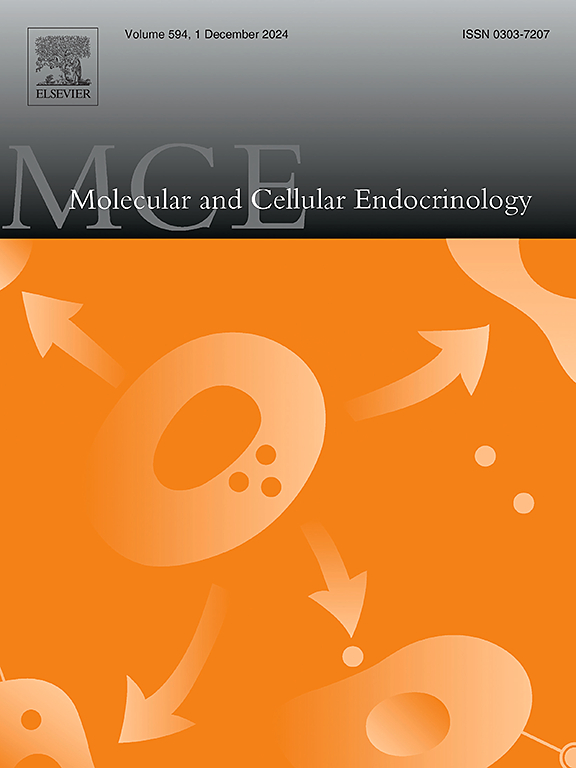c-Jun调节产后β-细胞凋亡和下游催乳素信号的存活。
IF 3.6
3区 医学
Q2 CELL BIOLOGY
引用次数: 0
摘要
妊娠和产后状态驱动母体β细胞团的动态扩张和收缩。关于是什么调节了产后衰退,我们知之甚少。我们最近对妊娠晚期和产后早期的小鼠胰岛进行了分析,以确定β细胞凋亡或存活的调节因子。其中一种是c-Jun,一种在多种组织中调节增殖、凋亡和存活的转录因子。在这里,我们研究了妊娠和产后以及小鼠和人类胰岛中c-Jun的调节和功能。为了研究c-Jun在β细胞中的调控作用,我们建立了缺乏β细胞催乳素受体(PRLR)的小鼠遗传模型,并用重组催乳素刺激人和鼠培养的胰岛。在MIN6细胞中,c-Jun的敲低是通过siRNA和慢病毒shrna完成的,或者在胰岛中使用药物抑制剂完成的。我们发现c-Jun在β-细胞中的表达暂时局限于妊娠晚期和产后早期,并且需要PRLR信号。此外,TUNEL染色发现c-Jun表达与凋亡的β-细胞互斥。催乳素处理在小鼠和人胰岛诱导MAPK/ERK信号下游的c-Jun表达。抑制c-Jun可通过促生存因子Bcl2l1 (Bcl-xL)和Birc5 (Survivin)阻断促凋亡应激后泌乳素介导的β-细胞存活。最后,来自妊娠供体的胰岛β-细胞中c-Jun表达增加,而来自妊娠糖尿病供体的β-细胞中c-Jun表达缺失。总之,我们的研究结果表明,c-Jun有助于β-细胞中PRLR / MAPK信号下游乳原的促生存作用。c-Jun调节在人类胰岛和妊娠中是保守的,在GDM中是失调的。本文章由计算机程序翻译,如有差异,请以英文原文为准。
c-Jun regulates postpartum β-cell apoptosis and survival downstream of prolactin signaling
Pregnancy and postpartum states drive dynamic expansion and regression of maternal β-cell mass. Little is known about what regulates postpartum regression. We recently profiled murine islets from late gestation and early postpartum to identify regulators of β-cell apoptosis or survival. One hit was c-Jun, a transcription factor which regulates proliferation, apoptosis, and survival in various tissues. Here, we examine c-Jun regulation and function during gestation and postpartum and in murine and human islets. To examine the regulation of c-Jun within β-cells we used a mouse genetic model lacking β-cell prolactin receptor (PRLR) and stimulation of human and murine cultured islets with recombinant prolactin. Knockdown of c-Jun in MIN6 cells was accomplished using siRNA and lentiviral-shRNA, or in islets using pharmacologic inhibitors. We found that c-Jun expression in β-cells is temporally restricted to late gestation and early postpartum and requires PRLR signaling. Moreover, c-Jun expression was mutually exclusive with apoptotic β-cells identified by TUNEL staining. Prolactin treatment induces c-Jun expression downstream of MAPK/ERK signaling in both murine and human islets. Inhibition of c-Jun blocks prolactin-mediated survival of β-cells following pro-apoptotic stress, via the pro-survival factors Bcl2l1 (Bcl-xL) and Birc5 (Survivin). Finally, islets from pregnant donors exhibit increased c-Jun expression in β-cells, while absent in β-cells from donors with gestational diabetes (GDM). Together, our findings indicate that c-Jun contributes to pro-survival effects of lactogens downstream of PRLR/MAPK signaling in β-cells. c-Jun regulation is conserved in human islets and pregnancy and dysregulated in GDM.
求助全文
通过发布文献求助,成功后即可免费获取论文全文。
去求助
来源期刊

Molecular and Cellular Endocrinology
医学-内分泌学与代谢
CiteScore
9.00
自引率
2.40%
发文量
174
审稿时长
42 days
期刊介绍:
Molecular and Cellular Endocrinology was established in 1974 to meet the demand for integrated publication on all aspects related to the genetic and biochemical effects, synthesis and secretions of extracellular signals (hormones, neurotransmitters, etc.) and to the understanding of cellular regulatory mechanisms involved in hormonal control.
 求助内容:
求助内容: 应助结果提醒方式:
应助结果提醒方式:


